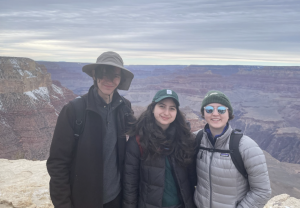The day began at 8:30 AM, when after another scrumptious breakfast of hotel buffet food, we ran into a random dog named 1812; he had a coat on that said “Beast Mode.” Unfortunately, he stayed true to his coat by growling at Aviva. Shucks.
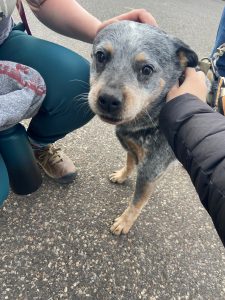
We piled into the vans, where we made a quick stop at a Mavericks for Fruit Gushers: Super Sour Berry candy (which, concerningly, Aidan bought 4 of) and gas. Selby did not buy snacks for Arlo’s van and it was noted.
Our first stop of the day was along Route 89; there, the scenic view was blocked by a fence adorned with stickers and signatures. Aidan pulled out a sharpie, and signed the fence with “@bmc_geology,” but Elena and Mishelley did him one better by finding stickers in their bags to add to the railing.
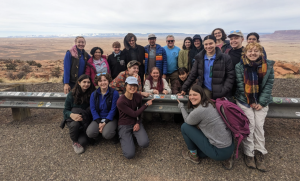
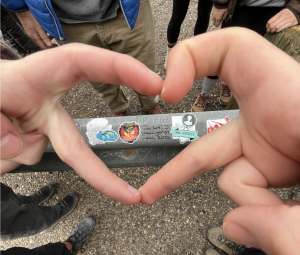
Our next stop was at Cameron Trading Post, which we saw billboards for throughout Arizona promising a one of a kind experience. It began in 1911 and acted as trading post for both goods and culture between Indigenous groups and settlers heading west. The group purchased things and trinkets – including shirts, bracelets, magnets, snacks (a pickle in a ziploc bag for Don), and shot glasses.
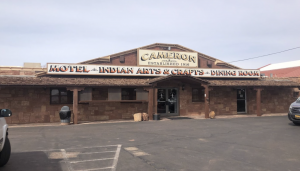

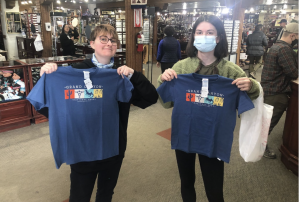
Arlo’s first lecture location was a scenic overlook to the less grand part of the Grand Canyon, the Little Colorado River, which is a river Arlo trespassed near to pee on Day 1. It’s good to see old friends again. The highlight of this stop was actually the stuff we were walking on. Arlo told Don not to tell us what the sedimentary structures were in the rock unit, but he misheard and thought Arlo was quizzing him, confidently and correctly answering “burrow marks.” Thanks for the answer, Don, you’re a real one!
These burrow marks were only the first of the sedimentary structures we’d see; we also saw ripples, pock marks, and euhedral crystals. After very incorrectly calling these rocks quartz-rich, we learned that they were calcite-rich. This rock unit was the Kaibab Limestone Formation, which dates back to the Early Permian. These pock marks were actually the result of the calcite in limestone experiencing dolomitization. Dolomite is smaller since magnesium is smaller than calcite, so the chemical weathering experienced caused the rock to shrivel at some parts and create small holes. These vugs sit on a plane parallel to bedding. Selby was so proud of our use of mineralogy to interpret these features! After all of these observations, we correctly said that this unit formed in a shallow marine environment that was heavily bioturbated (little critters burrowed, ate, and digested the sediments).
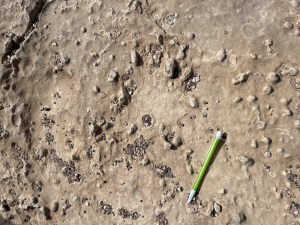
After looking up from the ground, we saw a distant basaltic cinder cone volcano, very creatively named “Black Knob”. Arlo turned our attention to the closer rocks however, and pointed out some disruption in the horizontal strata. This is where Aidan finally began to make good on his promise to not get any more questions wrong; Arlo asked for mechanisms that could accommodate this deformation, which Aidan noted could be two normal faults. After a discussion of fault dynamics and the average dip angles of faults, the group identified that the lowered block was a graben in a horst-graben system. In particular, Maya Hoffsteter correctly identified the direction of sigma-1 in normal faults; vertically. They later noted that “I’m tired of being wrong, I’m gonna be right this time” in response to being put on the spot by Arlo. They were not wrong.
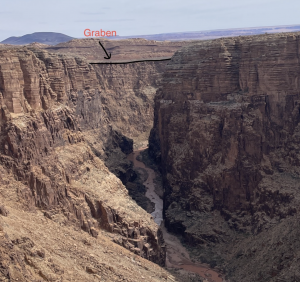
This stop also featured a majestic muppet of a dog and another dog driving a car! Unfortunately, it’s also the site where Alison twisted her ankle (rip) in efforts to take a photo of that very dog. Additionally, there were numerous Navajo vendors at this stop, and even more of our travelers acquired souvenirs of their time in Arizona. We made lunch, including Malin’s questionable “crunchy water” bag, and were off on our way to the climax of the trip.

We observed numerous monoclines and hogback formations on the drive, though ultimately, it was quite short as we arrived at the South Rim of the Grand Canyon itself within 20 minutes. There was snow on the ground, and tourists galore. We made our way to the edge, and took many, many pictures together. It was the Grand Canyon but for real this time. Arlo gave an extensive lecture on the history of the rock layers in the Grand Canyon to the delight of all the tourists trying to get a photo of the picturesque landscape.
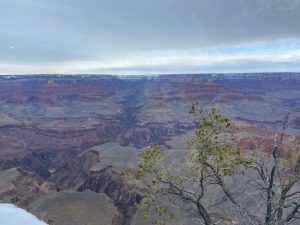
He quickly pointed out the Great Unconformity (notably, distinct from the Greatest Unconformity which we saw later that day). The Great Unconformity sees the Cambrian Tapeats Sandstone (part of the Tonto Group) truncating the Grand Canyon Supergroup (which includes the Chuar and Unkar Groups). This angular unconformity represents a period of 175 to 725 million years missing in the rock record. Let’s break down those groups a bit more.
The Grand Canyon Supergroup (GCS) was a part of a large-scale extension event during the formation of the Rodinia supercontinent around 1.2 billion years ago (the Grenville Orogeny). The Grenville was unique, as it resulted in extensional events, such as the dropdown of the South Rim relative to the North Rim accommodated by the Butte Fault. Laramide deformation was accommodated by numerous reverse faults which were later used again to accommodate Basin and Range extension as normal faults.
The Chuar group was a particularly marine group as these layers were either at or near sea level, indicating that they were formed during the breakup of Rodinia between 750-640 Mya. In a surprising twist of fate, Arlo had incredible things to say and stories to tell about the paleontological and sedimentological finds within this group (including a three meter high stromatolite he took a photo next to).

Arlo also reminisced about being stung by a scorpion while chilling at the bottom of the Grand Canyon with a bunch of Australians (he did not die, though he thought he was going to, while the Aussies laughed at his lack of bug knowledge). He also noted that the Grand Canyon has been a site of research on an extreme breadth of topics, including Neoproterozoic Snowball Earth.
We kept moving down the slushy path along the rim and stopped at an even snowier outlook. Arlo scared a few tourists by acting like he was about to fall backwards into the canyon, but he claimed he was joking… We still aren’t sure ourselves… He then began talking about the Greatest Unconformity. This is represented by the Vishnu Schist, composed of terranes, underlying the Tonto Group. This schist serves as the basis for the Greatest Unconformity, which sees crystalline schist underlying Tapeats Sandstone. The presence of crystalline rocks below sedimentary rocks makes this a nonconformity. This represents a gap on the order of a billion years!
Arlo also pointed out that there were dikes of Zoroaster Migmatite crosscutting the Tapeats Sandstone. A migmatite is a metamorphic rock that is formed by partial melting of the lower (granitic) crust. We saw these structures as pink dikes located within the Vishnu Schist.
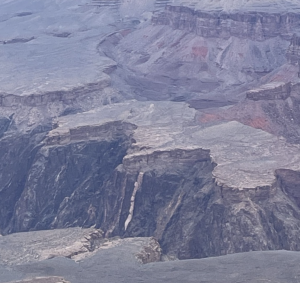
We also noted that the Muav Shale was one of the most eroded layers of the whole canyon. The presence of shale at this point was indicative of the transgression of the Panthalassa, further evidence of the breakup of Rodinia being cataloged in these rocks. Truly astounding!
On our final stop of the day, we took a brief (paved) hike out to visit the Grand Canyon Geology Museum and another gorgeous outlook. The museum had great summaries and dioramas of the formations and processes we had already been discussing, but they had a really great gift shop (which of course we shopped at). It’s always nice to see scientific concepts be made accessible to a general audience! We then reached our final outlook of the day, where we took innumerable photos of ourselves, the group, and the view, which was “okay, I guess.” Arlo noted that the location “looked dangerous, but wasn’t.”
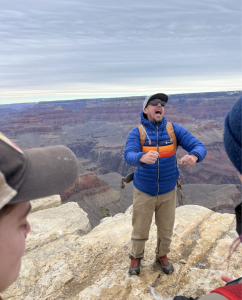
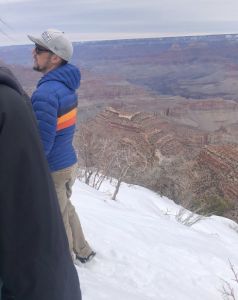
Arlo also took the time to correct some misconceptions (Disconceptions? Nonconceptions? Unconceptions?) about the naming scheme of unconformities, which the collective group appreciated! He continued by discussing methods to identify disconformities, or unconformities between sedimentary layers. We reasoned that, since if rock is exposed long soil develops, that every disconformity would have an associated soil layer (paleosol) between them.
The group traveled back to the vans, located at the Raven 1 lot, while exchanging stories of unfortunate emergency room visits. Arlo engaged Emily, Elena, and Aidan in a brief snowball fight, and shouted “Protected by strangers!” as passersby walked through the crossfire. The group saw some amazing amazing elk, and then arrived at the Red Feather Lodge and prepared for the Grand Canyon hike by relaxing and sleeping (and watching The Real Housewives of New Jersey).
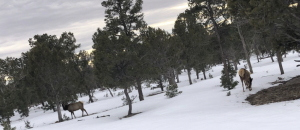
Quotes of the Day: “I hope this doesn’t offend anyone, I don’t think it will…” — Arlo
Days Without Arlo Shouting “ASTHENOSPHERE!”: 0
Dogs with sweaters: 5
Number of snowball fights: 1
Thanks for reading! Check back tomorrow for more geologic adventures.
Alison, Hannah, and Aidan
